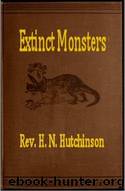Extinct Monsters A Popular Account of Some of the Larger Forms of Ancient Animal Life by H. N. Hutchinson

Author:H. N. Hutchinson
Language: eng
Format: mobi, epub
Tags: Paleontology
Published: 2013-04-23T00:00:00+00:00
Plate XIII.
GROUP OF SEA-SERPENTS, ELASMOSAUR, AND FISHES.
Fishes, Portheus. Elasmosaurus. Length 50 feet.
Beryx. Clidastes. Length 40 feet.
Osmeroides, etc. Mosasaurus. Length 75 feet.
But the reader inquires, âWhat is the nature of these creatures thus left stranded a thousand miles from either ocean? How came they in the limestone of Kansas, and were they denizens of land?â These creatures lived in the Cretaceous period. The remains found in this region were mostly those of reptiles and fishes. Thirty-five species of reptiles are known from Kansas alone, representing six orders, and varying in length from ten to eighty feet. One was terrestrial, four were fliers, the rest inhabited the ocean. âWhen they swam over what are now the plains, the coast-line extended from Arkansas to near Fort Riley, on the Kansas River, and, passing a little eastward, traversed Minnesota to the British possessions, near the head of Lake Superior. The extent of sea to the westward was vast, and geology has not yet laid down its boundary; it was probably a shore now submerged beneath the waters of the North Pacific.â
Other very elongated marine reptiles of this period, but with much thicker bodies, are called, by Professor Cope, Elasmosaurs. In this group, which is not yet fully worked out, occur such genera as Cimoliosaurus, Polycotylus, Polyptychodon, and others. But it seems a pity that they should be in any way separated from the Plesiosaurs, which they strongly resemble (see chap. iv., Plate III.). Though not sea-serpents, we have introduced them here because they flourished at the same time, and lived in the same seas with the Mosasaurs and other forms of that group. The very large teeth, with strongly marked ridges, of the Polyptychodon are abundant in the Cambridge Greensand that underlies the chalk, and represent a very huge animal.
In our illustration, Plate XIII., the artist has represented the Elasmosaurus[37] (of Cope) with its long thin neck stretched out in search of food on the bed of the sea. Professor Copeâthus describing this monster, in language which seems somewhat fancifulâsays, "Far out on the expanse of this ancient sea might have been seen a huge snake-like form, which rose above the surface, and stood erect, with tapering throat and arrow-shaped head, or swayed about, describing a circle of twenty feet radius above the water. Then plunging into the depths, naught would be visible but the foam caused by the disappearing mass of life. Should several have appeared together, we can easily imagine tall, flexible forms rising to the height of the masts of a fishing-fleet, or like snakes twisting and knotting themselves together. This extraordinary neckâfor such it wasârose from a body of elephantine proportions. The limbs were probably two pairs of paddles, like those of Plesiosaurus, from which this diver chiefly differed in the arrangement of the bones of the breast. In the best-known species twenty-two feet represent the neck in a total length of fifty feet. This is Elasmosaurus platyurus (Cope), a carnivorous sea-reptile, no doubt adapted for deeper waters than many of the others.
Download
Extinct Monsters A Popular Account of Some of the Larger Forms of Ancient Animal Life by H. N. Hutchinson.epub
This site does not store any files on its server. We only index and link to content provided by other sites. Please contact the content providers to delete copyright contents if any and email us, we'll remove relevant links or contents immediately.
Whiskies Galore by Ian Buxton(41879)
Introduction to Aircraft Design (Cambridge Aerospace Series) by John P. Fielding(33064)
Rewire Your Anxious Brain by Catherine M. Pittman(18552)
Craft Beer for the Homebrewer by Michael Agnew(18140)
Cat's cradle by Kurt Vonnegut(15183)
Sapiens: A Brief History of Humankind by Yuval Noah Harari(14251)
Leonardo da Vinci by Walter Isaacson(13181)
The Tidewater Tales by John Barth(12608)
Thinking, Fast and Slow by Kahneman Daniel(12072)
Underground: A Human History of the Worlds Beneath Our Feet by Will Hunt(12024)
The Radium Girls by Kate Moore(11921)
The Art of Thinking Clearly by Rolf Dobelli(10219)
A Journey Through Charms and Defence Against the Dark Arts (Harry Potter: A Journey Throughâ¦) by Pottermore Publishing(9232)
Mindhunter: Inside the FBI's Elite Serial Crime Unit by John E. Douglas & Mark Olshaker(9200)
Tools of Titans by Timothy Ferriss(8218)
Wonder by R. J. Palacio(8009)
Turbulence by E. J. Noyes(7936)
Change Your Questions, Change Your Life by Marilee Adams(7635)
Nudge - Improving Decisions about Health, Wealth, and Happiness by Thaler Sunstein(7615)
